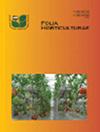16 个杏栽培品种花蕾在休眠期的耐寒性
IF 1.8
4区 农林科学
Q2 HORTICULTURE
引用次数: 0
摘要
花芽在休眠期受到的霜冻损害极大地威胁着杏的栽培效果。因此,评估栽培品种最重要的一个方面就是确定其耐寒性。本文研究了 16 个杏栽培品种花蕾在三个休眠期的抗冻性,采用了标准化的人工冷冻试验方案,并测定了 LT50 值。结果表明,基因型和年度气候条件对抗冻性都有显著影响。基因型通常决定了其潜在的最大抗冻能力('Sweet Red'和'Primaya'每年对霜冻都非常敏感,而'Harlayne'和'Rózskajszi C.1406'则可被视为抗冻)。根据硬化和脱硬期的温度条件,每年花蕾的抗冻性可以达到不同的水平。从产量保障的角度来看,在规划果园时,必须考虑并协调所选品种的抗冻性和种植地的条件。因此,充分了解不同杏栽培品种的抗冻性非常重要,应将其纳入栽培品种说明中。本文旨在为实现这一目标做出贡献。本文章由计算机程序翻译,如有差异,请以英文原文为准。
Frost hardiness of flower buds of 16 apricot cultivars during dormancy
The effectiveness of apricot cultivation is greatly threatened by frost damage to flower buds during the dormancy period. One of the most important aspects of the evaluation of cultivars is therefore the determination of their frost tolerance. In this paper, the frost hardiness of flower buds of 16 apricot cultivars was investigated in three dormancy periods, applying a standardised artificial freezing test protocol and determining LT50 values. The results showed that both the genotypes and the yearly climatic conditions had a significant effect on frost tolerance. A genotype generally determines the potential maximum of its frost tolerance (‘Sweet Red’ and ‘Primaya’ were very sensitive to frost every year, while ‘Harlayne’ and ‘Rózskajszi C.1406’ could be considered as frost hardy). Flower buds can reach different levels of frost resistance each year depending on the temperature conditions during the hardening and dehardening periods. From the point of view of yield security, it is essential when planning an orchard, to take into account and harmonise the frost hardiness of the cultivars selected and the growing site conditions. Therefore, it is very important to have adequate information about the frost hardiness of different apricot cultivars, which should be included in cultivar descriptions. This paper is intended to contribute to this goal.
求助全文
通过发布文献求助,成功后即可免费获取论文全文。
去求助
来源期刊

Folia Horticulturae
Agricultural and Biological Sciences-Horticulture
CiteScore
3.40
自引率
0.00%
发文量
13
审稿时长
16 weeks
期刊介绍:
Folia Horticulturae is an international, scientific journal published in English. It covers a broad research spectrum of aspects related to horticultural science that are of interest to a wide scientific community and have an impact on progress in both basic and applied research carried out with the use of horticultural crops and their products. The journal’s aim is to disseminate recent findings and serve as a forum for presenting views as well as for discussing important problems and prospects of modern horticulture, particularly in relation to sustainable production of high yield and quality of horticultural products, including their impact on human health.
 求助内容:
求助内容: 应助结果提醒方式:
应助结果提醒方式:


